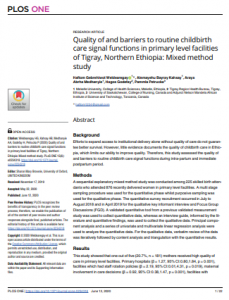
Background
Efforts to expand access to institutional delivery alone without quality of care do not guarantee better survival. However, little evidence documents the quality of childbirth care in Ethiopia, which limits our ability to improve quality. Therefore, this study assessed the quality of and barriers to routine childbirth care signal functions during intra-partum and immediate postpartum period.
Methods
A sequential explanatory mixed method study was conducted among 225 skilled birth attendants who attended 876 recently delivered women in primary level facilities. A multi stage sampling procedure was used for the quantitative phase whilst purposive sampling was used for the qualitative phase. The quantitative survey recruitment occurred in July to August 2018 and in April 2019 for the qualitative key informant interview and Focus Group Discussions (FGD). A validated quantitative tool from a previous validated measurement study was used to collect quantitative data, whereas an interview guide, informed by the literature and quantitative findings, was used to collect the qualitative data. Principal component analysis and a series of univariate and multivariate linear regression analysis were used to analyze the quantitative data. For the qualitative data, verbatim review of the data was iteratively followed by content analysis and triangulation with the quantitative results.
Results
This study showed that one out of five (20.7%, n = 181) mothers received high quality of care in primary level facilities. Primary hospitals (β = 1.27, 95% CI:0.80,1.84, p = 0.001), facilities which had staff rotation policies (β = 2.19, 95% CI:0.01,4.31, p = 0.019), maternal involvement in care decisions (β = 0.92, 95% CI:0.38,1.47, p = 0.001), facilities with maternal and newborn health quality improvement initiatives (β = 1.58, 95% CI:0.26, 3.43, p = 0.001), compassionate respectful maternity care training (β = 0.08, 95% CI: 0.07,0.88, p = 0.021), client flow for delivery (β = 0.19, 95% CI:-0.34, -0.04, p = 0.012), mentorship (β = 0.02, 95% CI:0.01, 0.78, p = 0.049), and providers’ satisfaction (β = 0.16, 95% CI:0.03, 0.29, p = 0.013) were predictors of quality of care. This is complemented by qualitative research findings that poor quality of care during delivery and immediate postpartum related to: work related burnout, gap between providers’ skill and knowledge, lack of enabling working environment, poor motivation scheme and issues related to retention, poor providers caring behavior, unable translate training into practice, mismatch between number of provider and facility client flow for delivery, and in availability of essential medicine and supplies.
Conclusions
There is poor quality of childbirth care in primary level facilities of Tigray. Primary hospitals, facilities with staff rotation, maternal and newborn health quality improvement initiatives, maternal involvement in care decisions, training on compassionate respectful maternity care, mentorship, and high provider satisfaction were found to have significantly increased quality of care. However, client flow for delivery service is negatively associated with quality of care. Efforts must be made to improve the quality of care through catchment-based mentorship to increase providers’ level of adherence to good practices and standards. More attention and thoughtful strategies are required to minimize providers’ work-related burnout.